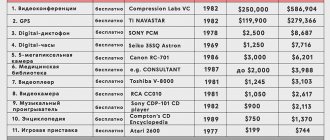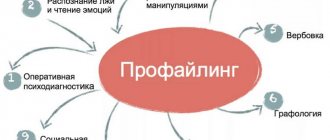Author: ProfGid
From English profile - profile. By the way, in 2021, the ProfGid career guidance center developed an accurate career guidance test. He himself will tell you which professions are suitable for you, and give an opinion about your personality type and intelligence.
A profiler is an expert in detecting lies based on a person’s facial expressions, gestures and manner of speaking.
Technological aspects
The profiler uses in its work the technology of “reading” body language, facial expressions and reading between the lines. For example, there is a suspect who wants to be “attached” with a case of committing a terrorist act. Naturally, when interviewing an investigator, this person monitors his speech and tries to control his behavior. But when the operational worker asks a question regarding the luggage that was left at the station, his eyes are filled with slight anxiety, he almost imperceptibly tenses his hand - this is what an experienced specialist should notice.
The art of identifying the smallest details in the manners and behavior of another person requires considerable knowledge and professional skills from the profiler. It is necessary to clearly understand what exactly you need to pay attention to and what can be relegated to the background. Often in his work, a profiler (verifier) uses a voice recorder or video camera to record a conversation or videotape the situation as a whole. This method works effectively, because with personal contact you can miss seemingly insignificant details, and the film captures everything. After the conversation, you just need to turn on the recording and listen/view it, doing some analysis.
The verifier observes facial expressions, gestures, behavioral characteristics, examines psycholinguistic patterns of speech, paralinguistic signs of verbal production.
The key mission of the profiler is to understand where the lies are. But at the same time, a specialist must understand when a person is sincere. After all, almost each of us, listening to a person whose dialogue is characterized by verbosity, confusion of the story, thoughtfulness over answers, nervousness, will immediately decide that he has become a victim of deception. As practice shows, such characteristics do not mean anything.
Profiler tasks:
- observing people;
- predicting people's actions and behavior;
- unmistakable determination of “empty” words and real human intentions.
A highly qualified profiler is the living equivalent of a lie detector.
How is this profession useful?
The profiler can easily describe the individual character of the alleged criminal and his personal behavior. This makes it possible to guess age, determine gender, specific habits, position in society and marital status. With this and other additional information, it is possible to determine the relationship with the potential victim and predict the criminal's next steps.
Each professional profiler has a different approach to the case, but most of them never visit a crime scene. They are engaged in a detailed study of photographs from crime scenes, expert reports and comparison of the data obtained with similar crimes. In research, great attention is paid not only to the smallest details, but also to the method and order of the criminal’s action. Having analyzed everything down to the smallest detail, this specialist can easily draw up a portrait of the criminal.
Some professional profilers, such as Mickey Pistorius, have no idea how they can investigate a crime without being at the scene where it was committed. They try to understand the thoughts of the criminal on the spot, so to speak, “get into his shoes,” but there are only a few of them, and most likely they are driven to this by the desire to be in the center of events and in every way to highlight their professional skills.
Knowledge of the smallest psychological subtleties helps profiling specialists not only to find murderers, but also to obtain from them sincere confessions of their crimes. An American investigator secretly shared a rather interesting tactic for conducting a very complex interrogation of a criminal who was suspected of the disappearance and subsequent brutal murder of a little girl in Canada. The police learned very little. It was reliably proven that the young unknown man called her over and invited her to get into the car. After which they left, and no one saw the girl again.
After detaining the suspect, the investigator had to use a certain trick. “I had a casual conversation with the suspect until I received a message that the poor woman’s body had been found. When I found out the details of what happened to her, that the girl was brutally raped and killed, and they didn’t even try to hide the body, I assumed that during the murder the perpetrator was experiencing a fit of anger. Earlier, in a conversation with the suspect, I had already found out that he had a strong quarrel with his girlfriend and left home. I tried to convince the criminal that I myself had experienced this many times and understood him perfectly. Thanks to a frank conversation, I convinced him that the attack of anger was completely justified, and the girl herself was completely to blame for what happened to her, since she dared to contradict him, which caused even greater rage. My convincing words provoked a repetition of his then state and he, without holding back his emotions and rage, began to talk first about the quarrel, and then about the murder of the girl,” says Robert Keppel.
The main directions of profiling, or What types of profilers are there?
Business profiling. This is a modern model of conducting business negotiations, in which not only partner parties take part, but also a third party - a profiler. Modern business people know firsthand what this innovation in the business sphere is. This specialist closely monitors his client’s interlocutors. He makes a conclusion regarding the seriousness of his partner’s intentions by assessing his behavior.
Bank profiling. The main character is a bank profiler. What it is? An innovative direction of control and a tool, the use of which allows you to reduce a significant proportion of non-repaid loans. But not everyone knows this. However, it is often possible to see that a profiler is observing the interview of bank employees with a potential borrower who has applied for a loan.
Audit profiling. It has been actively used by various auditing companies to verify the honesty of accounting workers. Now in financial statements they pay attention not only to the equality of debits and credits, but also to the behavior during the next audit of the accountant. This is done by the audit profiler. What it is? Almost all audit firms already know this new “means of protection” against all kinds of fraud in the financial sector and, if possible, are introducing such “innovation” at home. It is worth noting that such a check is an effective addition to the standard check of accounting papers.
Insurance profiling. It is used by insurance companies to prevent or identify all kinds of fraudulent schemes when applying for insurance.
Transport profiling is a way to identify passengers who may pose a danger to the public: mentally unbalanced and aggressive persons, persons carrying one or another weapon, etc. After all, such specialists have abilities that allow them to identify such persons without problems.
Hotel profiling. It is used as a preventive measure to avoid crimes of various types that may occur in the hotel.
Personnel profiling. It consists of “exposing” a candidate for a position and allows you to get to the bottom of what he will not write about himself - gambling addiction, criminal history, presence of particularly large debts, etc.
More recently, such a concept as family profiling was introduced - the ability to recognize the real intentions of the future husband, the difficulties in the life of a teenage son outside the family, and more.
In fact, there are a lot of areas for applying this specialty, and the most interesting thing is that this list continues to grow.
If we take it subjectively, then each of us can distinguish lies in a particular industry.
What it is
Sometimes you can meet individuals who, almost at one glance, can understand what their opponent is like. And this is not a superpower, it is just observation and the ability to correctly analyze the manner of communication and other inconspicuous behavioral characteristics that reveal much more about the interlocutor than he himself would like to say. Some people read such information intuitively, while for others there is a scientific technology called “profiling”, the tasks of which include the study of implicit signals present in the communication behavior of each individual.
So what is profiling? Simply put, this is a set of methods that help analyze the character of individuals and predict a behavioral model based on various indirect signs (non-verbal signals). Typically, the profiling process involves creating a psychological profile that outlines key character traits.
True profiling assumes that there is an established relationship between a certain trait and the existence of a corresponding character trait. Having established the type of person, determining his individual psychological characteristics, a fairly accurate and detailed psychological profile is compiled, according to which specialists can relatively accurately predict the individual’s further actions, find weak points and select a technique for influencing or interacting with the subject being analyzed.
Profiling techniques were originally used by security at an Israeli airport. The profiler’s task was to analyze the behavioral model of passengers and identify potentially unsafe subjects with hidden weapons or ammunition. The implementation of the considered set of technologies has yielded positive results. Today this airport is considered one of the safest.
Further, personality profiling continued its development, complemented by the latest techniques and methods, and also began to be used in other areas - in business, forensics, consulting, and recruiting.
How to become a profiler
Profiling is one of the specific forms of activity that combines different branches of the humanities, including art, history and others. Therefore, the future profiler must have a higher or incomplete higher education.
However, there is a fairly widespread opinion that a “live lie detector” must have not only a humanitarian education, but also a basic psychological one. This is explained by the fact that profiling is a psychological science. At the moment, there is no clear answer regarding whether an applicant for the position of a profiler must have such education.
Money
Profilers are paid hourly. The cost per hour depends on the complexity of the order and the authority of the profiler. If we talk about boundaries, participation in an interview costs from 15,000 to 55,000 rubles per hour, in negotiations - from 15,000 to 250,000. Training in the basics of profiling - from 30,000 to 150,000. Depending on how successful the client base has been collected profiler, he can earn from 200,000 per month or more. The best profilers receive offers from abroad, where the income level is even higher.
Knowledge
Working as a profiler implies a clear distinction between truth and lies and their analysis. A “living detector” must have the art of conducting a dialogue in such a way that the interlocutor reveals himself as much as possible both from the verbal side and from the side of gestures and facial expressions.
The profiler must understand:
- Human psychology.
- Emotional psychology.
- Human physiology.
- Emotional physiology.
- Typologies and methods of deception.
- Signs of deception are not only in speech, but also in facial expressions and movements.
- Techniques and methods for detecting deception.
Prospects
There are a maximum of five good profilers in Moscow. This is a fairly narrow specialization, and people who have the necessary skills are very highly regarded. More and more people are becoming interested in profiling, although, of course, not everyone is able to master the profession. The demand for profiling training is growing especially quickly, but most graduates of such academies still do not choose profiling as their main activity, but use their skills at work: in the human resources department, in a bank, in security services. The demand for profiler services is growing steadily.
Text: Siranush Sharoyan
Photos: Ksenia Kolesnikova
Skills
The profiler is responsible for:
- Organization and conduct of observations.
- Determination of a person’s psychotype based on external characteristics and behavioral characteristics.
- Identification of lies and truth, based on the technique of statements and speech construction.
- Finding one or another emotion of the interlocutor in microexpressions.
- Distinguishing blurred emotional expressions.
- Difference between gestures-emblems and gestures-illustrators.
- Finding leaks of reliable information.
- Using lie detection techniques.
Examples and interpretation of gestures and speech
And here’s where the fun begins – let’s look a little deeper into human psychology. In the section of examples, I will reveal several secrets on the operational diagnosis of a person, how to understand that they are trying to “cheat” you.
It is important to remember that deception always entails a chain of gestures, so the veracity of the information cannot be judged by just one of them. So, a person is lying to you when he displays the following gestures:
- touches the tip of the nose - here it is the tip that matters, since other parts of the organ have a different meaning;
- uncontrolled movements of the hands near the face (stroking the lips, forehead, temples, chin, rubbing the eyelid, lips, covering the mouth with the hand);
- tries to maintain a distance from the interlocutor (leaning his body away from the person, stepping back, moving away, crossing his legs under the chair);
- quickly rubbing hands is just that, fast, because if a person does it slowly, then the meaning changes radically;
- he pulls his legs under him and taps them on the floor.
The following verbal signs may indicate hypocrisy:
- Generalization of facts, concealment of essential details, presentation of information one-sided.
- Only short sentences are heard in speech, so as not to forget all the adjectives and adverbs that were carelessly added.
- A minimum of direct answers, constantly trying to evade: “I’m not the type to...”, “I think it shouldn’t be so one-sided...”
- An abundance of peremptory remarks like “I won’t tell anyone...”, “I won’t do anything...”, thereby trying to make you trust him.
- Changes the pace of speech, the hypocrite, pondering the presentation of information, slows down in his comments, and then, so as not to forget what he said, quickly speeds up.
- Repeats your words, for example: “Were you in the cafe yesterday?” - “Was I in the cafe yesterday? Yes". This is done in order to adapt to you and reduce your vigilance.
These interesting data about liars and hypocrites can be useful to you in negotiations or when communicating with unfamiliar people.
And in addition, watch this interesting video:
FAQ
Will I be able to read people after learning profiling?
To “read” people, it is not enough just to read an intelligent book. To “scan” a person you need to know the basics of psychology and be able to observe. Only in this case will it be possible to find out about a person what he is hiding.
Is it possible to determine by gestures whether a person will set me up or not?
Will he set you up or won't you set him up, no gestures are shown. But, knowing the basics of profiling, you will be able to predict a person’s behavior: whether he is deceiving you, whether he is ready to sincerely communicate with you or not. This science provides such data.
Will knowing profiling make my life easier?
This knowledge is universal. And they really make life easier. Forecast and knowledge of human psychology help prevent some mistakes or, conversely, provoke him to openness. You need to develop and study profiling even for everyday life.
Appearance
The main options for signs of appearance elements are given using the example of male faces.
When observing women's faces, you should keep in mind: their characteristics are the same, but the differences appear in the direction of the grace of facial features. The elements are smaller in size. They, as a rule, do not have extreme degrees of expression, for example, a large nose, a massive lower jaw, a protruding eyebrow, etc. But in general, this forensic classification is equally used to study both male and female faces.
Figure 1 shows the main options for the general configuration of the face (face shape), which are determined by its approximation to one of such well-known geometric shapes as a circle, oval, square, rectangle, triangle, rhombus.
Face shape
In order to understand the shape of a particular person’s face, it is necessary to mentally outline its contour or imagine which of the above-mentioned geometric figures it is closer to, which one, so to speak, fits into. In this case, in men, attention is paid to the structure of the lower jaw, which largely determines the shape of the face. For example, comparing image “a” with “e” in Figure 1, you can see how the lower parts of these faces differ.
The structure of the upper part of the human head, called the cerebral part of the skull by anatomists, also matters. Its shape can also be different, as can be seen in the pictures. But it can be hidden by a headdress and hairstyle.
Fig.1. general facial configuration (frontal shape): a – round; b – oval; c – square; g – rectangular; d – triangular; e – diamond-shaped.
Brows
Figure 2 shows options for eyebrow contours, determined by their upper edge, which is compared with a straight, arched one. Winding, broken lines. Sometimes the upper edge forms the top of a triangle, and the lower edge forms its base. The contour of such eyebrows is called triangular.
Eyebrows are also distinguished by their position relative to the eyes (a conventionally horizontal line connecting the outer and inner corners of each eye).
Classification of personality psychotypes in profiling
Professional profilers classify people into 8 main psychotypes:
- Hysteroid. Such a person is distinguished by demonstrative behavior. The main thing for a hysteroid is attention, which he is able to achieve by any manipulation. He clearly shows his strengths, admires himself and his vices. Compliments make him happy, but lack of attention makes him feel deprived. Loves aesthetics in appearance and everyday life.
- Epileptoid. A person of this type likes to influence other people and strives for power and control. At the same time, he feels the limits of what is permitted and does not allow himself to go beyond them. Also does not tolerate pressure on himself. Unlike the hysteroid, the epileptoid does not show off his merits and does not set himself the task of achieving universal recognition. His own respect is enough for him. This is a reliable person who values friendship, but does not always know how to control negative emotions.
- Paranoid. He has a disruptive character, a high level of energy and a desire for personal effectiveness. It charges itself quickly and charges everyone around it. Disadvantages of this type: impatience of criticism from others, stubbornness and imperviousness to feedback.
- Emotive. Such people feel increased responsibility for others; they are overly sympathetic and understanding. They feel sorry for their whining friends, homeless animals, and hungry children. They are easy to manipulate. The appearance of emotive personalities is characterized by modesty, inconspicuousness, and naturalness.
- Hyperthym. Considered the happiest personality type. His hormonal background allows him to almost always be in a good mood. Such a person is the soul of any company, he easily finds a common language with a wide variety of people, he is cheerful and active. Disadvantages of hyperthym: high distractibility, it is difficult for him to concentrate on routine tasks, he is not too susceptible to other people's experiences.
- Schizoid. A person prone to reflection and reflection. Such a person is able to think through various technologies, he constantly scrolls through a large amount of information in his head, analyzes and evaluates his own and others’ behavior. He is process oriented rather than result oriented. Appearance is not very valuable to him.
- Anxious and suspicious. A person of this type can be unbalanced by any remark, pressure or personal failure. Frequent worries take away a lot of his energy and desire to work. At the same time, he also has advantages: high empathy, a sense of justice, perseverance, exactingness, perseverance in achieving results.
- Depressed and sad. A loner who prefers reading books and watching movies to real communication with people. Very restrained and careful, weakly susceptible to other people's problems and pains.
Despite the fact that this classification is simple and convenient in practical use, it is still a simplified model. Unambiguous assignment of a person to one type or another is possible only after careful research and observation.
I recommend reading what other types of human personality are distinguished in psychology and socionics.
Areas of application
Areas in which profiling is in demand:
- Forensics. The method allows you to understand the personal characteristics of serial killers and create their psychological portrait. Includes the application of knowledge from criminology, psychiatry and psychology.
- Special direction. During the Soviet Union, the method was used by KGB officers to identify spies. Today, this area is still relevant and deals with the detection of persons prone to terrorism and extremist activities.
- Aviation. In this area, profiling helps to identify potentially dangerous passengers during pre-flight inspection. Today this method is used in almost all airports in the world.
- Research activities. The main person here is Paul Ekman, a famous American psychologist who studied microexpressions and the definition of emotions. It was thanks to his theory that profiling reached a new level of development and began to penetrate other professional areas. Ekman's research became the basis for training programs for security officers in legal, banking, and government organizations.
- Medical and psychological direction. Based on the research of famous psychiatrists Peter Gannushkin and Karl Leonhard, methods were developed that are widely used in modern psychiatry.
- Psychotechnological sphere. It is this area of profiling that underlies NLP (neurolinguistic programming), the goal of which is to improve the effectiveness of communications between people to achieve what they want. Simply put, subtle manipulation techniques.











